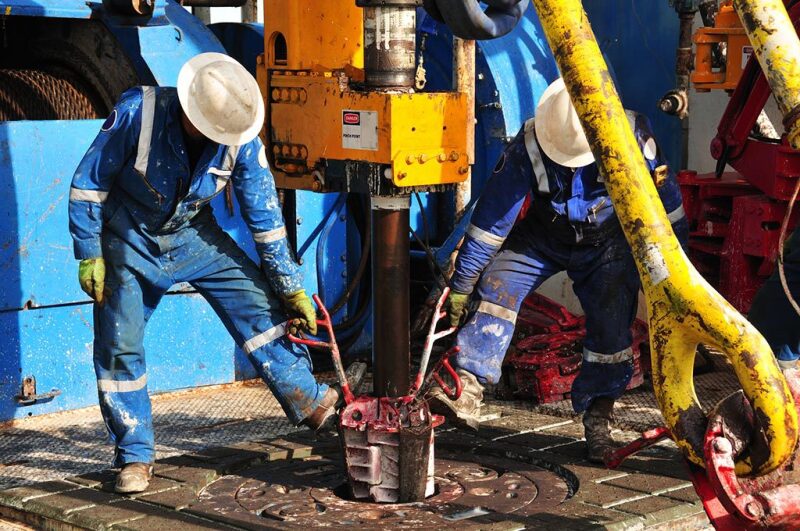Cementing is an essential part of the oil well and with deeper wells drilled, the performance of cement decides the life of the well even more critically. Cement undergoes many changes from the time it is mixed on the surface and pumped downhole and allowed to set. The varying temperature changes from surface to downhole along with the exothermic reaction of the setting cement creates a complex series of events which decides the fate of the well. With the advent of new technology and research cement performance has been improved several folds.
An essential part of oil well drilling today, cement had a very humble beginning. In 1903, fifty sacks of Portland Cement were dumped in a well to shut the downhole water in Lompoc field, California by Union Oil Company. Water zone was directly above the oil sands and after 28 days of waiting on the cement to set, water zone was observed to be completely isolated. Slowly, the use of cement was found to be beneficial for oil wells and construction Portland cement was brought to use. However, as more number and deeper wells were drilled, complications were observed. The American Petroleum Institute (API) set up a Cement Committee in 1937 to study cements and testing procedures to implement in oil and gas wells. Oil-well Portland cements were thereafter produced, which had higher consistency between one batch and another and had testing procedures more relevant to downhole conditions (Barnes and Bensted 2002). The term Portland is used only for the fact that it resembles the rock obtained from Isle of Portland in Dorset, England.
Cement Performance Characteristics
Portland cement has four major components: C3A, C2S, C3S, and C4FA. Although each component has its own characteristic reaction, eventually they all contribute to forming a strong solid matrix to act as a barrier. The cement matrix primarily consists of Ca(OH)2 and CSH which form an intricate rock-like structure. The hydration reaction plays a pivotal role in defining the life of the cement. As the cement solidifies, the matrix that takes shape has the structural property of any rock and can be defined in terms of porosity, permeability, compressive strength, shear bond strength (with casing pipe), mineral composition etc.
Once pumped into the well, cement is subject to several extreme downhole conditions, which may lead to a rapid degradation of cement. It is the study of these properties which can help in understanding the life of cement and hence, life of the well.
Cement Degradation Under HPHT CO2 Sequestration
Recently, with an increase in the demand for CO2 sequestration and enhanced oil recovery (EOR) techniques in high-pressure/high-temperature (HPHT) wells with deeper profiles and narrower window for pore- and fracture-pressure regime, cement design has undergone a substantial change. The understanding of degradation of cement under such conditions is imperative to bring about the changes in the cement formulation.
It is very interesting to note that the degradation of cement under CO2 conditions begins with a strengthening process of forming CaCO3. This is evident from the reduction in porosity and permeability and also increase in compressive strength. This increment in strength is short lived as CaCO3 is slowly leached out in the form of Ca(HCO3)2. This has been presented in the works of several authors such as Santra and Sweatman (2011), Benge (2009), Duguid (2009), Kutchko et al. (2007), and Gerard et al. (2002).
CO2 + H2O → H2CO3 (1)
H2CO3 + Ca(OH)2 → CaCO3 + 2H2O (2)
CSH + H2CO3 → CaCO3 + amorphous silica + H2O (3)
CaCO3 + H2CO3 → Ca(HCO3)2 (4)
There are several approaches to understanding and improving the life of cement under extreme HPHT conditions. One of them is simulation and analytical equations. There is work done by researchers to simulate the cement degradation reactions; however, with several variables in the picture it becomes difficult to arrive at a given set of equations which can precisely model the process.
Experimental procedures are preferred over simulation as they provide a more tangible solution, though empirical in nature. Works by Omosebi et al. (2017), Alsaiari et al. (2017), Skopra et al. (2019), and Srivastava et al. (2014, 2019) show the amount of interest around the world in replicating the HPHT conditions to understand the degradation. One of the most effective ways observed is to have an aging cell, which can create the downhole conditions of extreme temperatures and pressures. This allows the cement samples to be subjected to the near actual conditions without the risks of an actual wellbore. By controlling the amount of pressure, temperature, and partial pressure of individual gas components (CH4, CO2), the cement core samples can be made to depict the degradation response to various conditions.
Once cement samples are prepared under API regulation in the lab and cured, they are subjected to aging cell conditions. This allows conditioning of the cured and hardened cement samples in HPHT conditions. A detailed study of the behavior of this aging on the properties of cement (porosity, permeability, compressive strength, shear bond strength, mineral composition etc.) indicates the trend of degradation and allows a look at possible improvement of the cement. During the experiment, depending on the duration of exposure to HPHT conditions, formation of only CaCO3 may be observed. This should not be confused with the fact that subjecting cement to CO2 helps strengthen the matrix. As observed in Fig. 1 in the series of experiments performed by Srivastava (2014), the porosity and permeability were observed to decrease after ageing.

This reduction in porosity and permeability was also supported by the Fourier Transform Infrared Spectroscopy analysis, which indicated higher levels of CaCO3 in the matrix. During testing, an increase in compressive strength was simultaneously observed for the samples showing the positive effect of CaCO3 reinforcement.
To counter this carbonation effect (and eventually the degradation by leaching out), cement slurry can be modified with additives. These additives may be able to either reduce the porosity and permeability of the matrix to avoid penetration of CO2 or may carry out a sacrificial reaction with CO2 to prevent carbonation of the cement matrix.
Application of Latex and MgO has been studied widely in order to help reduce the porosity and permeability of the cement matrix. MgO has the property of expanding even after the cement is set and hence filling up the micro-annuli created during curing process. It has been successfully implemented in certain conditions subject to the temperature deration.
Several studies are still being conducted to understand the behavior of cement matrix downhole and its reaction with CO2 and H2S. The increasing demand for CO2 sequestration and EOR techniques push the wellbore to be subjected to unconventional scenarios and hence a different approach is essential to increase the life of the wellbore.
References
Alsaiari H.A., Sayed M., Reddy B.R., Metouri S., and Al-Taie I. 2017. The Importance of the Stability of Cement Sheaths: Interaction between Cement, Acid, Carbon Steel, and Formation and Treatment Fluids. SPE-188922-MS, Abu Dhabi International Petroleum Exhibition & Conference, 13−16 November, Abu Dhabi, UAE. https://doi.org/10.2118/188922-MS
Barnes, P. and Bensted, J. 2002. Structure and Performance of Cements. Second Edition, London: SPON Press.
Benge, G. 2009. Improving wellbore seal integrity in CO2 injection wells. Energy Procedia, Vol. 1, 3253–3529.
Duguid, A. 2009. An estimate of the time to degrade the cement sheath in a well exposed to carbonated brine. Energy Procedia, Vol. 1, 3181–3188.
Gerard, B., Le Bellego, C., and Bernard, O. 2002. Simplified modeling of calcium leaching of concrete in various environments. Materials and Structure, Vol. 35, 632–640.
Kutchko, B., Stratzisar, B., Dzombak, D.A. Lowry, G.V. and Thaulow, N. 2007. Degradation of well cement by CO2 under geologic sequestration conditions. Environ. Sci. Technol., Vol. 41, 4787–4792.
Omosebi O. A., Ahmed R. M., Shah S. N., 2017. Mechanisms of Cement Degradation in HPHT Carbonic Acid Environment, SPE-184567-MS, SPE International Conference on Oilfield Chemistry, 3–5 April, Montgomery, Texas, USA. https://doi.org/10.2118/184567-MS
Santra, A. and Sweatman, R. 2011.Understanding the Long-Term Chemical and Mechanical Integrity of Cement in a CCS Environment. Energy Procedia, Vol. 4, 5243–5250.
Skorpa R., Werner B., and Vrålstad T. 2019. Effect of Mud on Cement Sheath Integrity. SPE-195625-MS, SPE Norway One Day Seminar, 14 May, Bergen, Norway. https://doi.org/10.2118/195625-MS
Srivastava A. 2014. Effects of Additives on Oil Well Cement Under HPHT Acidic Environment, MS Thesis, University of Oklahoma.
Srivastava A., Ahmed R. M., and Shah S. N, 2019. Carbonic Acid Resistance of Hydroxyapatite-Based Cement, SPE-193585-MS, SPE International Conference on Oilfield Chemistry, 8–9 April, Galveston, Texas, USA. https://doi.org/10.2118/193585-MS



